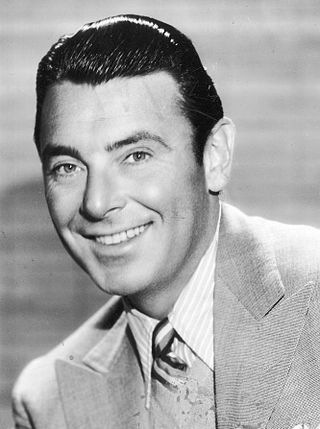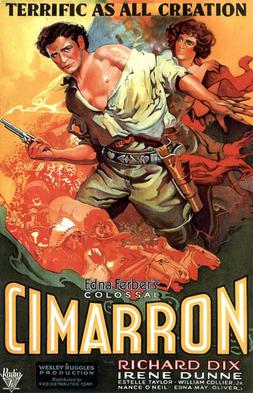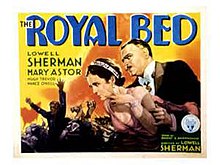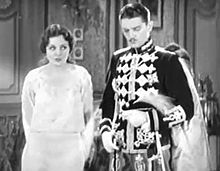
Ann Harding was an American theatre, motion picture, radio, and television actress. Harding was a regular on Broadway and on tour in the 1920s. In the 1930s Harding, was one of the first actresses to gain fame in the new medium of "talking pictures," and she was nominated for the Academy Award for Best Actress in 1931 for her work in Holiday.

Anne Baxter was an American actress, star of Hollywood films, Broadway productions, and television series. She won an Academy Award and a Golden Globe, and was nominated for an Emmy.

George Brent was an Irish-American stage, film, and television actor. He is best remembered for the eleven films he made with Bette Davis, which included Jezebel and Dark Victory.

The Painted Desert is a 1931 American pre-Code Western film released by Pathé Exchange. Produced by E. B. Derr, it was directed by Howard Higgin, who also co-wrote the screenplay with Tom Buckingham. The picture stars low-budget Western stars William Boyd and Helen Twelvetrees, and most notably features an unshaven young Clark Gable in his talking film debut. The film was shot mostly on location in Arizona.

John Villiers Farrow, KGCHS was an Australian film director, producer, and screenwriter. Spending a considerable amount of his career in the United States, in 1942 he was nominated for the Academy Award for Best Director for Wake Island, and in 1957 he won the Academy Award for Best Adapted Screenplay for Around the World in Eighty Days. He had seven children by his wife, actress Maureen O'Sullivan, including actress Mia Farrow.

Cimarron is a 1931 pre-Code epic Western film starring Richard Dix and Irene Dunne, and directed by Wesley Ruggles. Released by RKO, it won Academy Awards for Best Picture, Best Adapted Screenplay (written by Howard Estabrook and based on Edna Ferber's 1930 novel "Cimarron", and Best Production Design.

Gertrude Lamson, known professionally as Nance O'Neil or Nancy O'Neil, was an American stage and film actress who performed in plays in various theaters around the world but worked predominantly in the United States between the 1890s and 1930s. At the height of her career, she was promoted on theater bills and in period trade publications and newspapers as the "American Bernhardt".

Lowell Sherman was an American actor and film director. In an unusual practice for the time, he served as both actor and director on several films in the early 1930s. He later turned exclusively to directing. Having scored huge successes directing the films She Done Him Wrong and Morning Glory, he was at the height of his career when he died after a brief illness.

Helen Marie Twelvetrees was an American actress. She starred in Hollywood films in the sound film era from 1929 to 1939. Many of her roles were of "suffering women,” which reflected her tumultuous personal life. She has a star on the Hollywood Walk of Fame located at 6263 Hollywood Blvd.

Herbert Sydney Wilcox CBE was a British film producer and director.

Pathé Exchange, commonly known as Pathé, was an American film production and distribution company, largely of Hollywood's silent era. Known for its trailblazing newsreel and wide array of shorts, it grew out of the American division of the major French studio Pathé Frères, which began distributing films in the United States in 1904. Ten years later, it produced the enormously successful The Perils of Pauline, a twenty-episode serial that came to define the genre. The American operation was incorporated as Pathé Exchange toward the end of 1914 and spun off as an independent entity in 1921; the Merrill Lynch investment firm acquired a controlling stake. The following year, it released Robert J. Flaherty's groundbreaking documentary Nanook of the North. Other notable feature releases included the controversial drama Sex (1920) and director/producer Cecil B. DeMille's box-office-topping biblical epic The King of Kings (1927/28). During much of the 1920s, Pathé distributed the shorts of comedy pioneers Hal Roach and Mack Sennett and innovative animator Paul Terry. For Roach and then his own production company, acclaimed comedian Harold Lloyd starred in many feature and short releases from Pathé and the closely linked Associated Exhibitors, including the 1925 smash hit The Freshman.

Millie is a 1931 American pre-Code drama film directed by John Francis Dillon from a screenplay by Charles Kenyon and Ralph Morgan, based on a novel of the same name by Donald Henderson Clarke. The film was an independent production by Charles R. Rogers, distributed by RKO Radio Pictures, after their acquisition of Pathé Exchange. It stars Helen Twelvetrees in one of her best roles, with a supporting cast that includes Lilyan Tashman, James Hall, Joan Blondell, John Halliday and Anita Louise.

Beau Ideal is a 1931 American pre-Code adventure film directed by Herbert Brenon and released by RKO Radio Pictures. The film was based on the 1927 adventure novel Beau Ideal by P. C. Wren, the third novel in a series of five novels based around the same characters. Brenon had directed the first in the series, Beau Geste, which was a very successful silent film in 1926. The screenplay was adapted from Wren's novel by Paul Schofield, who had also written the screenplay for the 1926 Beau Geste, with contributions from Elizabeth Meehan and Marie Halvey.

Transgression is a 1931 pre-Code American drama film directed by Herbert Brenon, using a screenplay written by Elizabeth Meehan, adapted from Kate Jordan's 1921 novel, The Next Corner. The film stars Kay Francis, Paul Cavanagh, and Ricardo Cortez, and deals with the romantic entanglements of a wealthy English businessman, his wife and a Spanish nobleman.

White Shoulders is a lost 1931 American pre-Code comedy-drama film directed by Melville W. Brown and starring Mary Astor and Jack Holt, with major supporting roles by Ricardo Cortez and Sidney Toler. The film was produced and distributed by RKO Pictures. The screenplay by Jane Murfin and J. Walter Ruben was adapted from Rex Beach's short story, The Recoil.

Girl of the Port is a 1930 pre-Code melodramatic adventure/romance American film directed by Bert Glennon. The screenplay was written by Beulah Marie Dix and Frank Reicher based on the short story "The Fire-walker" by John Russell. The film stars Sally O'Neil, Reginald Sharland, Mitchell Lewis and Duke Kahanamoku.

Beyond Victory is a 1931 American pre-Code war film starring Bill Boyd, James Gleason, Lew Cody, and ZaSu Pitts. While John Robertson received directing credit, Edward H. Griffith supposedly took extensive re-takes after production ended and the film was deemed not audience ready. Two actresses with major roles in the original version were completely cut from the final release, Helen Twelvetrees and June Collyer. The original screenplay was written by Horace Jackson and James Gleason. While the film might not have made a profit at the box office, it was well received by critics.

By Your Leave is a 1934 American domestic comedy film directed by Lloyd Corrigan from a script by Allan Scott, Lewis Foster, and Sam Mintz. The screenplay was based on a play of the same name by Gladys Hurlbut and Emma B. C. Wells, which had a short run early in the year at the Morosco Theatre. The film was produced by Pandro S. Berman, and starred Frank Morgan and Genevieve Tobin, although several other actresses were initially scheduled to appear in the film, including Mary Astor and Ann Harding. Both stars were on loan to RKO from other studios. It marked the film debuts of two notable Broadway actors, Glenn Anders and Gene Lockhart, the latter of which had a lengthy Hollywood career. By Your Leave opened on November 9, 1934, and received mostly positive reviews.

Hugh Trevor was an American actor whose short career began at the very end of the silent era in 1927. He would appear in nineteen films in the scant six years during which he was active. He did not fare well with the advent of talking pictures, and retired from the industry in 1931. His life was cut short when he unexpectedly died from complications following appendectomy surgery in 1933.























